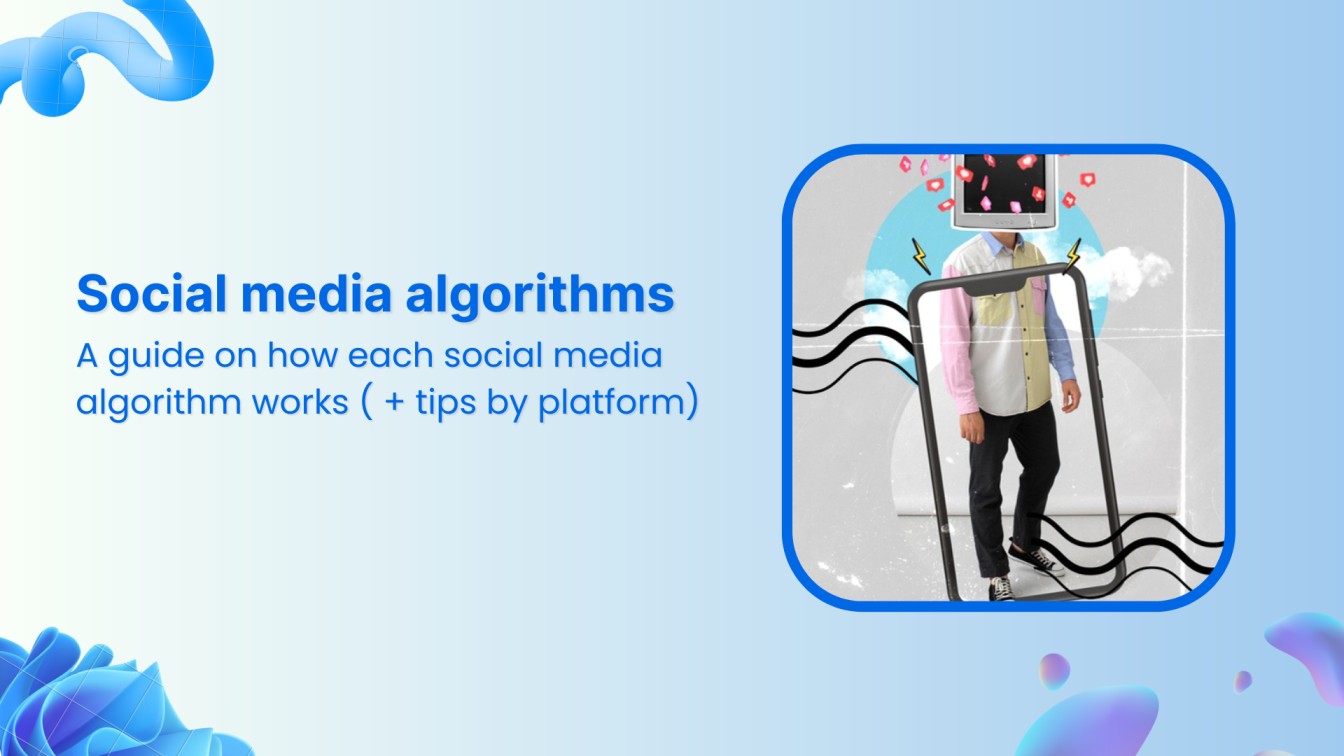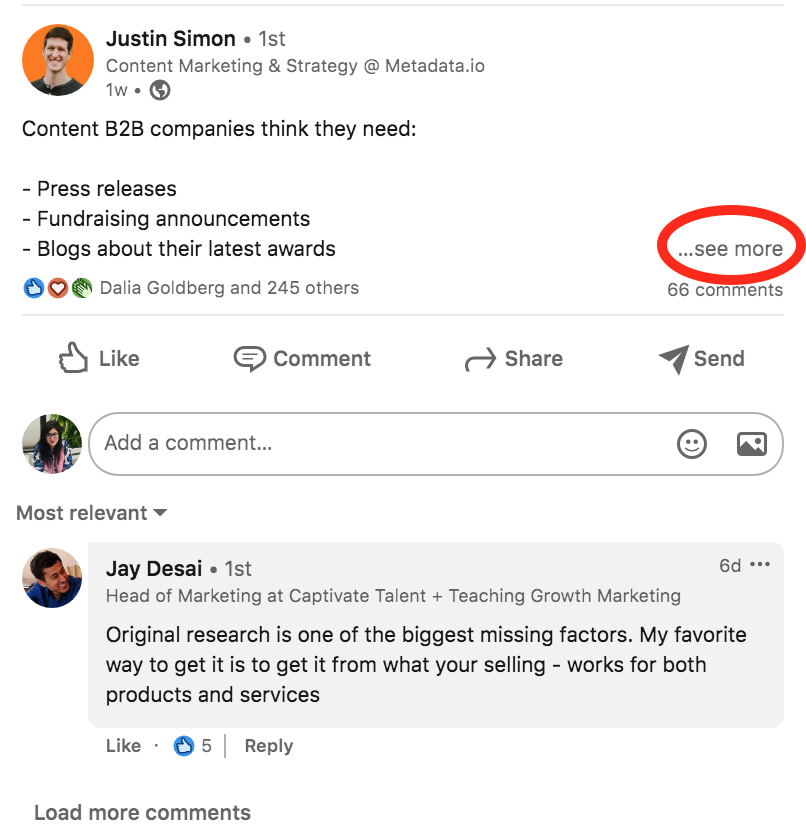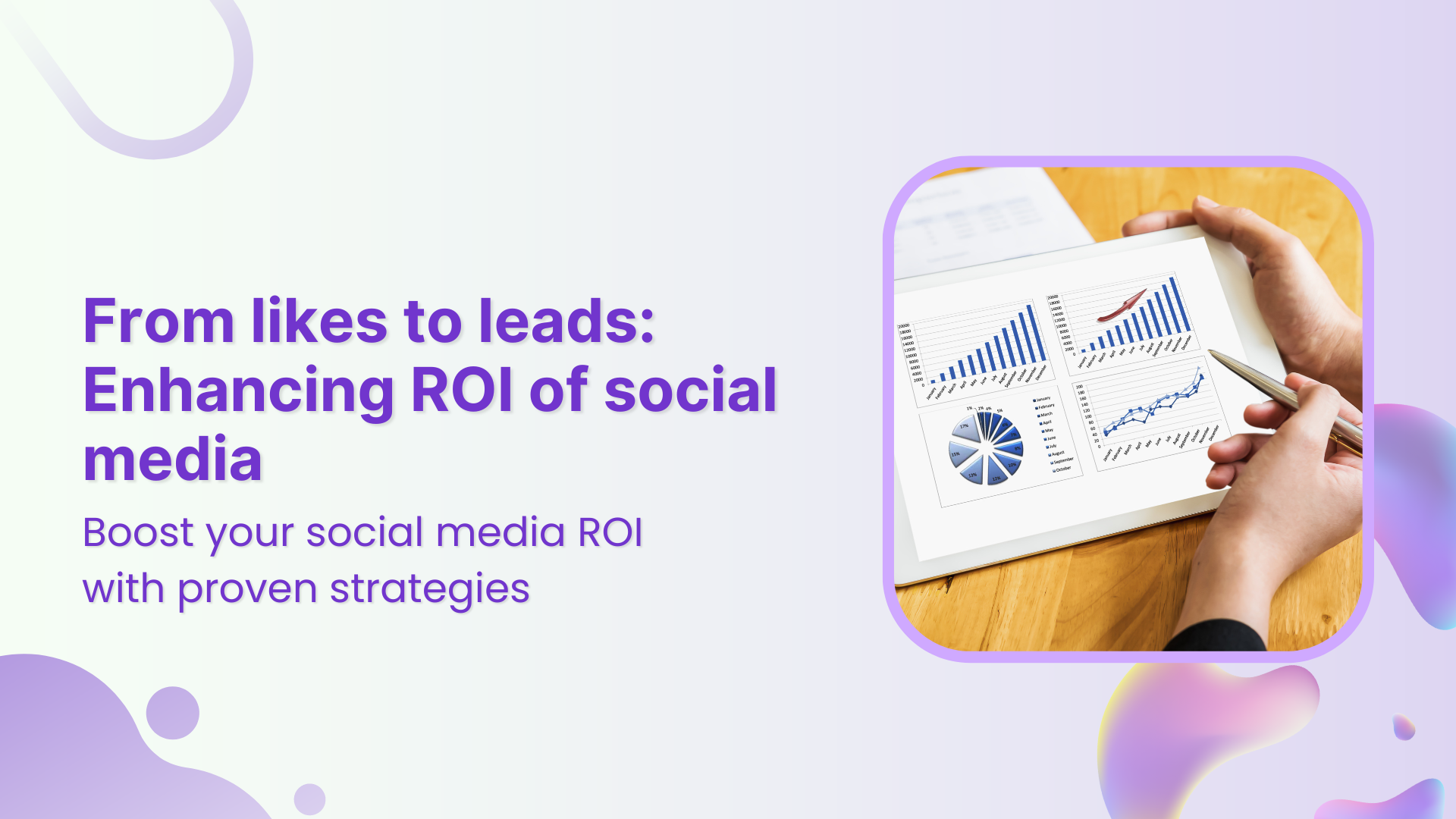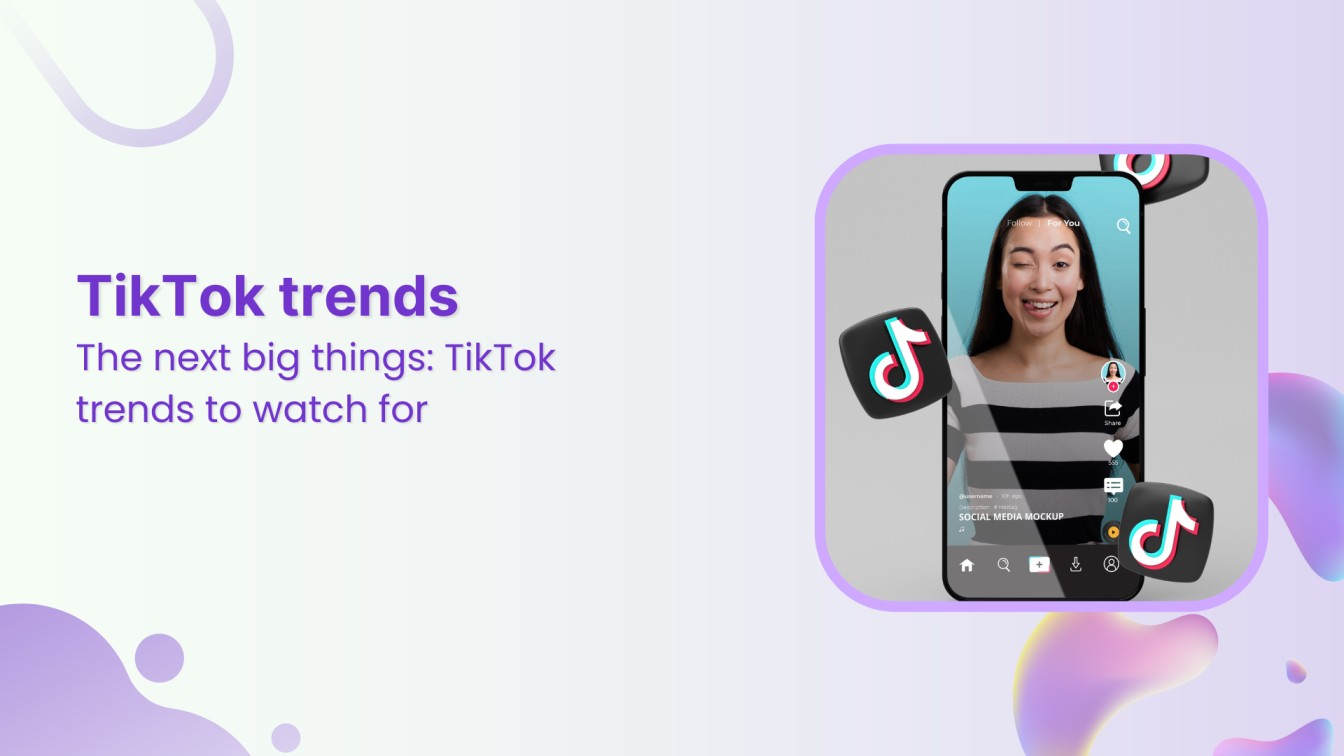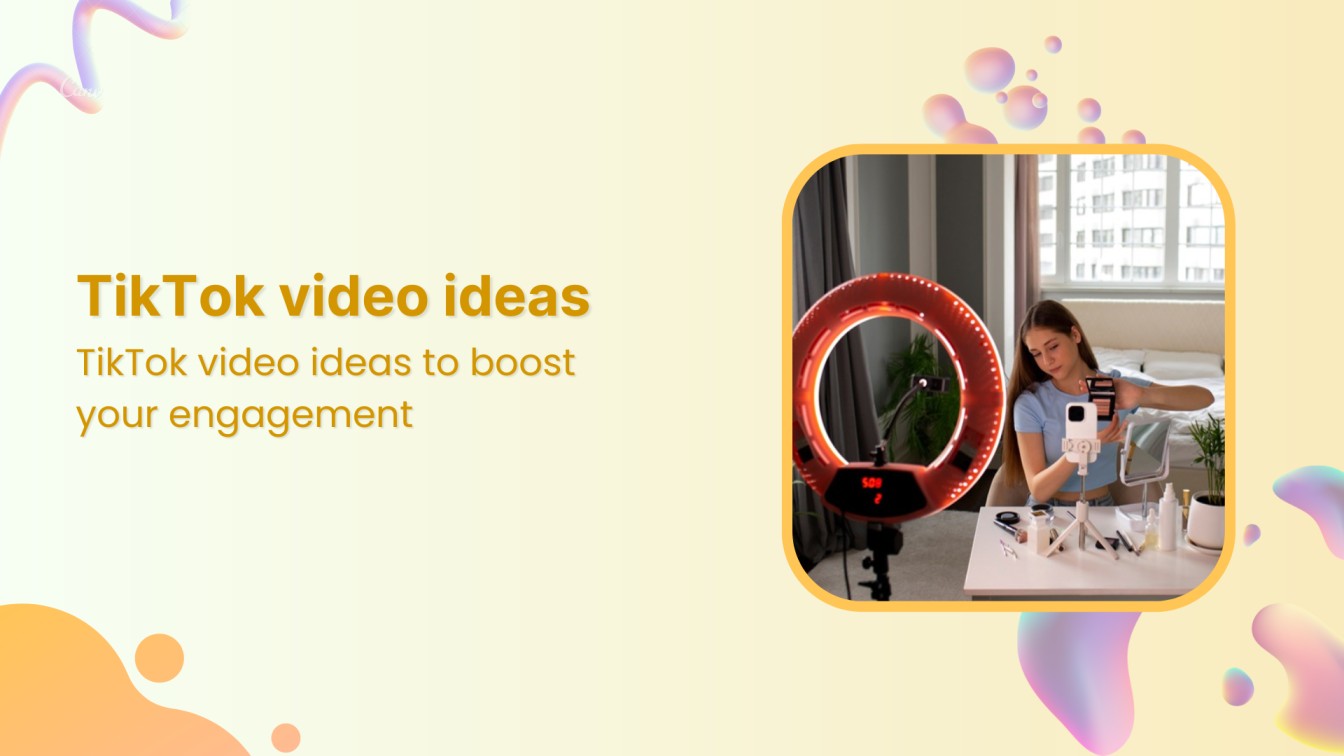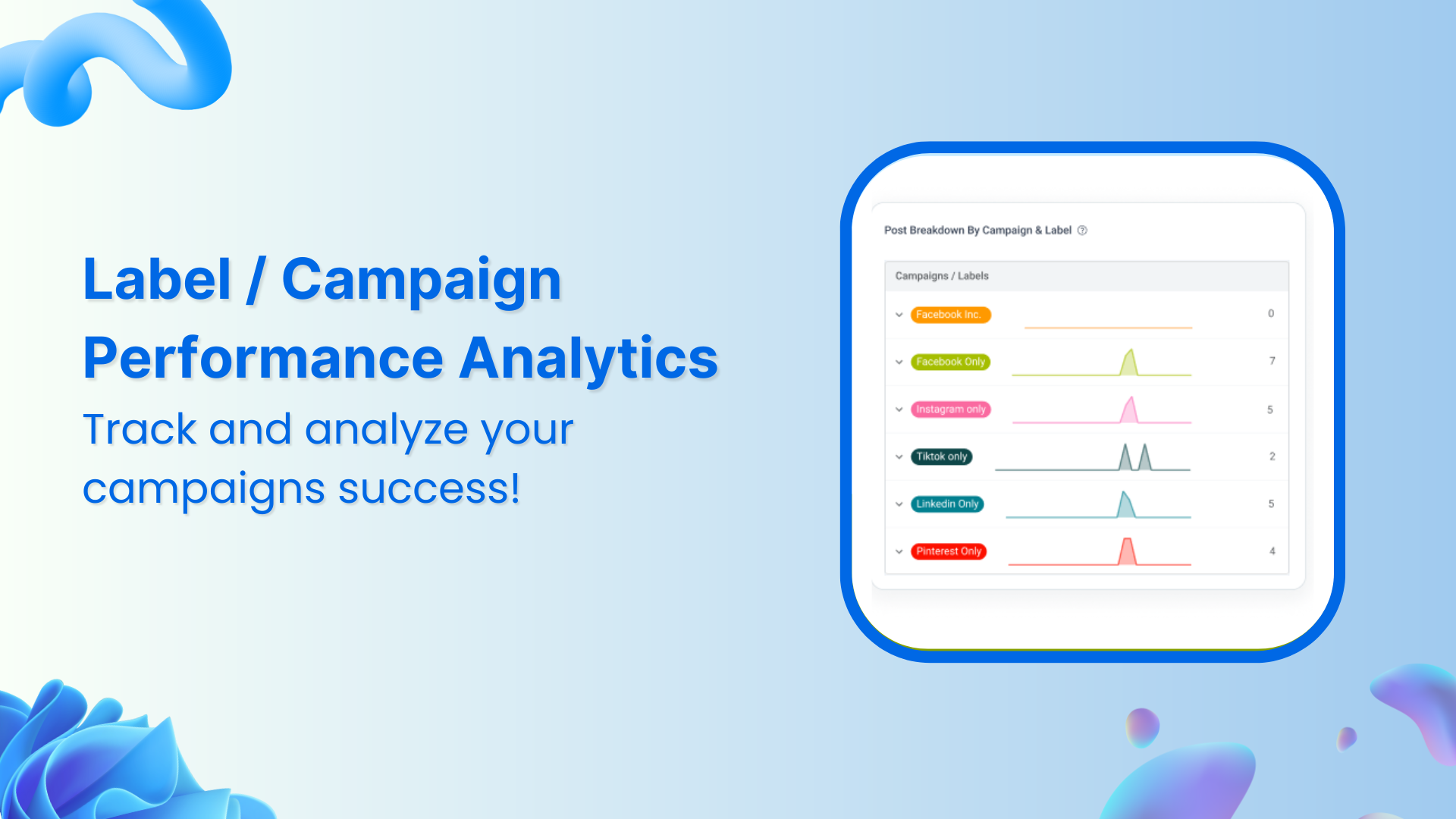How do social media algorithms work? Admittedly, the answer to this is never easy to find.
In fact, you’d think you’ve cracked a social media algorithm only to find out the network announced some changes, and you’re back to square one.
This, of course, doesn’t mean you give up keeping updated with algorithm changes. Because at the end of the day, you need a sound understanding of how you can get your social posts to rank and attract engagement.
So, to make things easy for you, we’ve created this guide on all the social media algorithms and their key factors. This way, as you draft your social media marketing plan, you’ll know how to grow your audience.
Ready to learn? We’ve also got tips on ranking on each channel and improving your ROI.
Let’s get on with it.
But first: What are social media algorithms?
Social media algorithms are channel-specific AI-powered recommendation engines that decide which content shows to which users and in what order.
All social algorithms work differently.
However, their priority tends to be the same: increasing the time users spend on the platform by showing them content that’s uber-relevant to them.
For this reason, all algorithms typically study users’ interests to serve them useful content that they’re likely to engage with.
Most social media algorithms also prioritize recency or content freshness – ranking fresh content higher than day-old content.
How do social media algorithms work?
Social media algorithms are complex systems designed to personalize and optimize user content delivery. While each platform has its unique algorithm, it is generated based on a combination of user behavior, engagement metrics, content characteristics, and network connections. Here’s a breakdown of how social media algorithms typically work:
Key factors influencing social media algorithms:
User engagement:
-
- Likes, comments, shares: Content that receives more engagement is often promoted, as it is deemed interesting or valuable.
- Time spent: A user’s time on content can signal its relevance or quality.
User behavior:
-
- Interaction history: Algorithms track the type of content users have interacted with previously and prioritize similar content.
- Search history: Searches can influence the type of content shown, as the algorithm assumes relevance to the user’s interests.
Content characteristics:
-
- Type of content: Videos, images, and text posts might be weighted differently. For instance, video content might be prioritized due to higher engagement rates.
- Freshness: Newer content is often given priority to keep the feed up-to-date.
- Relevance and quality: Keywords, hashtags, and overall content quality affect how content is ranked.
Network connections:
-
- User’s network: Content from friends, family, or frequently interacted with accounts is prioritized.
- Mutual interactions: If two users frequently interact, content from one is more likely to be shown to the other.
Let’s have a look at algorithms channel-wise.
Instagram algorithm: How to use IG for your business the right way in 2024
The Instagram app is divided into three sections – feed, reels, and explore. Each section has its specific algorithm tailored to display personalized content for every user. Instagram ranks posts based on these ranking signals:
Instagram feed
Your Instagram feed is a mix of content from accounts you follow, similar profiles you’ll likely enjoy, and personalized ads. In the feed, posts are ranked based on several signals:
Recency
Accounts with more recent postings display before those with older ones.
Individuals you follow
Posts from people you follow naturally appear in your feed. For Instagram creators, this means that becoming more visible comes with having more followers.
User activity
Your preferred material is conveyed by the posts you’ve liked, shared, saved, or left comments on.
Content type
Photographs will be shown more to those who are photophobic. The same holds true for Instagram carousels and Instagram reels.
Post-information
Posts with many likes, shares, comments, and saves indicate interest to other users who share the same interests or area.
Interaction history
How often and how you respond to an account’s posts determines which appear in your feed.
Instagram stories
Users can upload images or videos to Stories, an in-app feature that expires in a day. This is how it appears:
An image from Instagram Stories showing several bubbles.
The Instagram feed’s ranking criteria and those for stories are somewhat comparable. Stories employ indicators of involvement like:
Viewing history
An account’s stories would be prioritized if they were frequently viewed.
Engagement history
One engagement indicator that affects story rankings is liking or commenting on stories.
Closeness
The Instagram algorithm considers your interactions with the article’s creator, such as mutual following, locations you’ve shared, and direct messages.
Instagram Explore
Explore makes it easier to find new posts without the need for an active search. This is how it looks on Instagram: Three separate Explore feeds are shown side by side. The grid shows content recommendations from accounts you don’t follow that Instagram thinks you might like. Signals that Instagram takes into account are:
User’s past interaction
Content is ranked based on previous engagements with posts.
Post popularity
The number of likes, comments, shares, and saves influences visibility.
User’s explore activity
history of a user’s interaction on the Explore page, including liked posts and similar content.
Account information
The frequency of interaction with the account in the last few weeks.
Instagram Reels
Like Explore, Instagram Reels allow users to discover fresh material from accounts they do not follow. Important cues for Reels content consist of:
User activity
Recent involvement includes likes, saves, shares, comments, and other interactions with Reels.
Interaction history
Even if you don’t follow accounts, you can still view your past interactions with them.
Relevance
Popular indications like as likes, saves, and comments help assess how relevant a piece of content is.
Account details
Content recommendations are based on an account’s popularity, which includes the number of followers and interaction level.
Instagram Marketing Schedule your Instagram posts, Reels, and Stories, and get recommended best time to publish for maximum engagement.


How can brands use Instagram to maximize their ROI?
Based on how the Instagram algorithm works, here’s what you need to be doing:
- Create audience-relevant content: You cannot grow on Instagram without creating content that interests your target audience.
- Engage with your audience: Of course, you can’t follow each one of them. But getting back to comments and replying to DMs are surefire ways to get your content in front of your followers while growing strong relationships with them.
- Post consistently and when your audience is online: Don’t go overboard—two weekly posts are a good publishing cadence.
Bonus tips:
-
- Use the right hashtags: Doing so will help you increase your discoverability and engagement. Here’s how to use hashtags the right way on Instagram.
- Diversify your content mix: From carousels to bite-sized reels and memes, provide an engaging content mix to keep your audience hooked.
- Encourage engagement: Ask questions, host contests and giveaways, and create branded hashtags to prompt customers to share their pictures with your products (read: plan user-generated content).
YouTube algorithm: How to use YouTube for your business the right way in 2024
YouTube’s ranking signals, as follows, enable it to captivate people for hours on end:
Watch history
YouTube values your watch history and makes content recommendations based on your previous views.
Video performance
Like other social media sites, YouTube prioritizes content that receives many likes, views, and click-through rates.
Click-through rate
YouTube’s algorithm determines how likely a user will interact with a video before recommending it to others.
Watch time
YouTube will probably show you more content about a channel or topic you view frequently.
Context
YouTube prioritizes videos that users watch together frequently as a video streaming platform. Consequently, similar videos appear next to the video you are streaming.
Recency
Subscribers that engage with the channel are given access to newer videos.
Search history
What did the user look up? Is it a recurrent query?
Demographics and location
When videos produced by local creators are promoted locally, local viewers are given priority over global viewers.
X (Twitter) algorithm: How to use Twitter for your business the right way in 2024
The Twitter algorithm has many moving pieces. Instead of selecting information chronologically, it uses artificial intelligence (AI) to curate content based on user preferences, interests, and past interactions. Twitter claims its algorithm scans through 500 million tweets daily to show you only the most relevant ones on your timeline.
That is, it’s at work in several areas, such as:
Language and location
Twitter, particularly in its “Trends for You” area, displays content to you according to your location.
User interactions
These consist of the accounts and tweets that you regularly interact with.
Engagement level
To gauge the popularity of tweets, user interaction metrics, likes, retweets, Twitter impressions, and replies are used.
Relevance
A tweet’s relevance is determined by its terms, the user’s interests, and past interactions.
Customizable timeline
Or the timeline you create by creating Twitter Lists. Within this custom timeline, you can see tweets in either chronological order or home timeline fashion.
Trends and popularity
These show up in several places, including the home timeline. Sometimes, the blue-bird network gives context around why something is trending. Other times, you’re left to guess why.
Twitter considers the degree of interaction and activity from individuals inside your network and the current popularity of a topic, trend, or tweet.
Topics
The Twitter algorithm recommends these based on what it thinks you like or interact with. You can always choose Topics to see more content from and tell Twitter the Topics you aren’t interested in. Twitter also prefers recent topics that make it to the “What’s Happening” sections. On the other hand, location affects what shows up in trends. (Read up on humor as a Twitter engagement tactic)
Profile reputation
Twitter also employs TweetCred, a PageRank algorithm, to score a profile’s credibility based on its followers, prior activity, safety status, and device usage. This is known as the Profile Reputation Score. Active profiles that interact with others have higher visibility.
Who to follow (suggested accounts)
These recommended accounts are based on promoted accounts, your Twitter activity, location, and contacts if you’ve uploaded them on the network.
That said, Twitter doesn’t explain how its algorithm works in detail. It only says the ranking engine shows content based on your interests, whom you engage with, and the tweets you interact with.
Other than that, there’s not much detail that the Twitter team shares.
X (Twitter) Marketing Schedule perfectly crafted tweets and manage your X (Twitter) content with a unified content calendar.


How can brands use Twitter to maximize their ROI?
Take the following steps:
- Tweet regularly: Consistent tweeting is an effective recipe for growing visibility and engagement. Be sure to keep self-promotion to a minimum, though. Focus on providing value instead.
- Tweet when your audience is active: Be clear on who your target audience is and when they will likely be active. After you’ve tweeted a few times, see which time brings your content the most engagement. Also, your audience will likely miss a tweet if you send it out during a niche-popular Twitter chat hour.
- Engage with your followers: Retweet their tweets, leave comments, respond to messages and comments, and encourage your audience to interact with you.
- Use keywords in your content: Study competitors, industry influencers, and creators who talk about similar topics. Find out which keywords they’re using and use the same in your tweets.
- Include rich media in your tweets: Post a healthy mix of tweet formats, from bite-sized videos to branded GIFs and graphics. Test different content formats to determine which ones grow your engagement.



Build Trust with Curated Content
Discover, brand, and share the best content with your audience. Establish yourself as an authority and turn leads into loyal customers.
14 days free trial - no credit card requiredLinkedIn algorithm: How to use LinkedIn for your business the right way in 2024
Like other social media algorithms, the LinkedIn algorithm prioritizes users’ time on the app by showing posts relevant to their interests and those they’re likely to engage with.
As a means of this, the algorithm uses the following ranking signals to show content to its users:
Content relevance
LinkedIn studies its users’ behavior by reading the posts, people, pages, and hashtags they interact with. In fact, whatever users do on the platform is used to determine their interests, serve them relevant content that interests them, and get them to spend more time on the app.
Content quality
The first ranking signal highlights the post’s quality. Based on this, your material may be classified as spammy, low quality, or high quality. On the other hand, LinkedIn has an opinion about what constitutes high-quality material. It takes into account how simple a post is to read, incorporates powerful keywords, uses two to three hashtags, and promotes answers.
Connections
The LinkedIn algorithm also looks at users’ varying degrees of connections. The professional network shows content to users based on how close the connection is (first, second, or third degree).
Of course, the larger your network on LinkedIn, the higher your content’s odds of showing to more people. Also, if users interact with a particular LinkedIn creator – no matter the connection degree – they’ll likely see more content from them.
Consistency
Pages with frequent posts are given more visibility by the algorithm.
Credibility
Post rating is improved by the author’s experience, perceptive writing, and thoughtful comments.
Recency
LinkedIn’s algorithm gives weight to posts made recently.
Content type
Well-structured long-form content and short-form videos are highly valued by the algorithm.
Engagement
On LinkedIn, comments are more important than reactions. Reactions, in turn, are more important than shares. That’s how the algorithm ranks content, too: It spreads content that gets more comments than content that attracts more reactions.
Another essential ranking factor is the dwell time or the time users spend on your posts.
If they pause for only a bit or not at all, the LinkedIn algorithm considers the content irrelevant to them. However, if they spend more time—also clicking the “see more” option to read the post—the algorithm rewards the post with more exposure.
How can brands use LinkedIn to maximize their ROI?
With that, here’s what you can do to get your content to rank better on LinkedIn:
- Grow your network: Connect with people in your industry and interact with them. Instead of liking their posts, leave thoughtful comments on their content. This way, they’re likely to reciprocate the engagement – helping your content reach a wider audience beyond your immediate connections.
- Leave meaningful comments: Leaving comments is a great way to get people to reciprocate by commenting on your posts.
But there’s more: long comments encouraging people to “see more” tend to get more engagement on the platform. This, in turn, tells the algorithm you have lots of value to share, so it pushes your content further.
- Tag people for more engagement: Also, it’s a good idea to tag people to prompt them to engage with your content. However, be sure to tag people who will engage than ones who might not respond or may remove the tag. The latter signals the algorithm that you’re spamming people. The result? It reduces your exposure.
LinkedIn Marketing Establish your brand’s profile on LinkedIn by consistently posting engaging content and engaging with the community.


Facebook algorithm: How to use Facebook for your business the right way in 2024
Facebook has more than 3.07 billion users globally, making it the most popular social media platform. Facebook is a very important platform for brands and marketers to win the algorithm and reach a larger audience, especially with that figure. Therefore, while developing your marketing plans, keep the following ranking signals in mind:
Recency
How fresh that content is with newer posts shown first.
Timing
Timing is given top priority by Facebook’s algorithm as a crucial indication for content ranking in user feeds. Utilize the best time to post on Facebook.
Demographics
Predicting a user’s preferred content can be aided by their location, language, and gender.
Content-type
You will see a particular content format more frequently in your feed the more you view it. For instance, the system will show you more reels on your feed if you interact with them more.
Content quality
Major ranking indications also include content correctness, informativity, and authenticity. Independent fact-checkers at Meta safeguard material quality by pushing posts down in feeds if they are found to be partially or outright untrue.
Relevancy
Users with similar interests are recommended posts with comparable hashtags or phrases.
Facebook friends and followers
Facebook primarily prefers showing content from your friends and the pages you follow.
Popularity
This includes how much engagement a post gets. The more popular it is, the more it’s likely to get exposure on Facebook.
Engagement
Facebook prioritizes meaningful post creation, so significant engagement—including likes, shares, and comments—indicates excellent content, which is why it gets ranked higher.
Facebook Marketing Manage and grow your brand on Facebook. Create, schedule, and publish posts, videos, and Reels to Facebook pages and groups.


How can brands use Facebook to maximize their ROI?
Based on how the Facebook algorithm 2024 works and its ranking signals, follow these tips:
- Share audience-relevant content: This is essential for growing your engagement and signaling the algorithm that your content interests your audience.
- Post regularly: Make sure you publish when your audience is active on Facebook. This is crucial for checking off the recency ranking signal.
- Create content in different formats: Try short explainer videos, custom GIFs, and text-based posts. Don’t forget that live video is very popular on Facebook.
TikTok algorithm: How to use TikTok for your business the right way in 2024
Understanding TikTok’s algorithm is crucial since, unlike other social media sites, it surfaces original content instead of content from users you currently follow. The recognized ranking signals are as follows:
Past user interactions
This is how the TikTok algorithm determines users’ interests. It looks at everything from the accounts a user follows, the creators they search for and those they’ve hidden, comments they make, videos they favorite, videos they report as inappropriate, videos they label as not interesting, and videos’ watch time. It also looks at content a user creates on their own account.
Using this data, the platform evaluates your preferences and how they evolve. TikTok ranks videos based on this data for each and every user.
Video information
The video data, which includes noises, effects, subtitles, and TikTok hashtags, aids the algorithm in determining the topic of a given piece of content and its ranking on the For You page.
Device and account settings
These include location setting, the device a user is using, language preference, and the selected interests. Since these are one-time settings, though, the TikTok algorithm doesn’t look at these signals as much as the two above.
That said, the TikTok algorithm is against duplicate content, content users have already seen, and potentially spam content.
Watch time
Your feed is influenced by the number of replays and finished videos.
Place and language
You may prefer content written in your native language or from your own nation.
Trends
Adding popular sounds and effects to your content can increase its discoverability.
How can brands use TikTok to maximize their ROI?
Here’s what to do:
- Create content that will engage your niche audience: Remember that the TikTok algorithm doesn’t rank content based on your follower count or past viral videos that have been successful on the platform.
This means if you’re relatively new on TikTok, audience-relevant, engaging content can help you go viral on TikTok without having to first work on building a following.
- Write compelling captions: Make sure you add relevant keywords here, too. The reason? TikTok captions are a great way to tell your audience about your video. In doing so, they can increase your engagement and video completion rates.
- Post when your target viewers are active: While this is important for all social networks, it’s particularly important here, as active engagement with your video is a key ranking signal.
Pinterest algorithm: How to use Pinterest for your business the right way in 2024
Compared to the other social media sites, Pinterest operates somewhat differently. It is far more search-oriented.
Nevertheless, an algorithm is needed even for the ranking of search results. According to Pinterest, “Quality and relevance matter more than frequency.” The recognized Pinterest ranking signals are as follows:
Website quality and ownership
The most important ranking element is the ownership and quality of the website. In this case, the quality is determined by how popular the pins are that link to a website. Therefore, Pinterest gives material from a given website priority if pins from that website are popular on the network.
Engagement
Another important ranking factor is the evaluation of pinners’ individual pins and accounts to determine engagement levels.
Recency
The algorithm considers the recent updates and publication dates of a pin.
Bonus tips for optimizing your content for each social media algorithm
Before we wrap this up, here are two more tips for improving your engagement on social.
1. Study your social analytics to optimize content
Look for when your audience is active on each social channel. Also, determine which topics and post types garner the most engagement.
Studying this is essential for better understanding your audience and reaching them better on social media.
You can always search for these critical metrics using each social platform’s in-built analytics. However, if you’re looking for in-depth analytics in one place, you’ll need to pick from social media analytics tools.
Our recommendation? ContentStudio. Using our multi-channel social analytics, you get a snapshot of your:
-
-
- Reach
- Engagement
- Audience growth
- Top performing posts
-
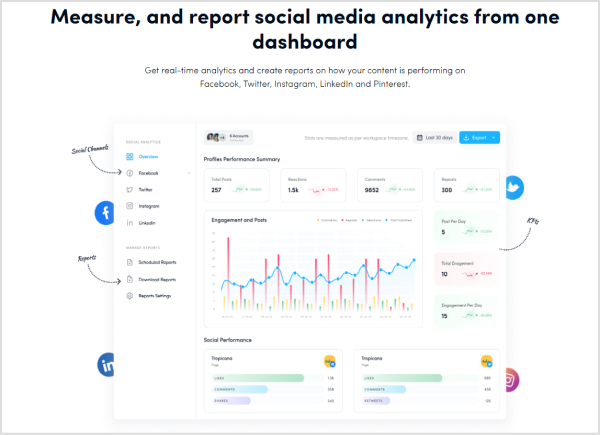


You can also analyze likes, comments, content type, and more to highlight which type of content resonates best with your audience.
2. Study what your competitors are up to
You also need to choose from competitor analysis tools. The aim? To learn which type of content your competitors are posting, what’s working for them, what they’re possibly doing wrong, the hashtags they’re using, and more.
Again, ContentStudio can help you with its competitor analytics feature that shows you relevant data on what’s working for any competitor, domain, industry – or even topic.



You can easily learn which content type performs best and which social networks competitors and others in the industry use. You can also identify your audience’s sentiment around a topic, which is an excellent way to refine your social media content plan.
3. Learn about your target audience
Content relevance is a ranking signal for all social algorithms. This is because social media algorithms exist solely to present users with excellent material that they are likely to find interesting.
Warning: Most people do not find anything that can be considered irrelevant interesting.
Relevance varies depending on the platform, but it always comes down to knowing your target audience and producing content that speaks to them directly.
4. Recognise the best posting times
Recent involvement and early engagement are important ranking signals in many algorithms. This implies that you must ascertain when your audience members are most likely to be online and using each social media network.
ContentStudio lets you do just that with its best times to post suggestions!
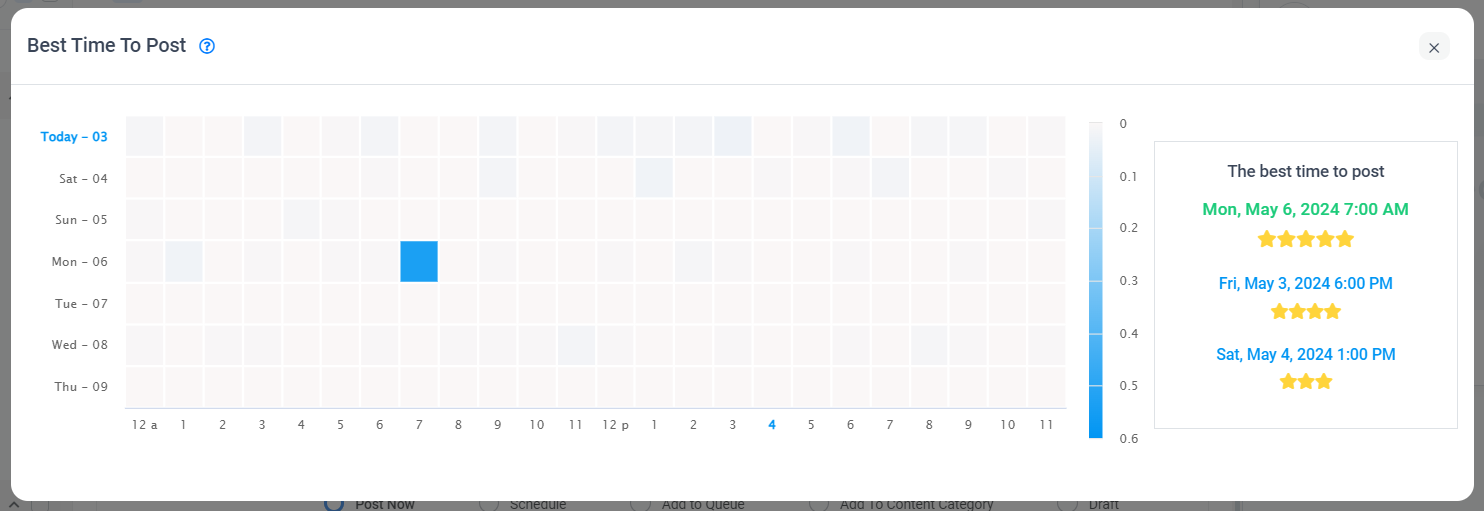


5. Attract likes, saves and comments
One significant ranking factor for social media algorithms is audience involvement. How, then, do you obtain that?
Naturally, the secret to getting more likes, shares, and comments on your material is to make it engaging. Asking for it is an easy way to boost engagement that works well.
Post a question in the caption of your image, or use the first comment to start a conversation. You can also start polls on stories and host giveaways.



Wrapping up
A business or individual must understand social media algorithms to succeed in today’s digital environment. By comprehending algorithmic processes and applying appropriate techniques and tools, one can enhance one’s presence, outreach, and interaction on social media platforms.
But because the algorithms are always changing, keeping up with the most recent developments can be a little challenging. The burden of producing high-quality material and scheduling its publication makes this challenge more difficult.
ContentStudio’s scheduling tool can simplify things. It can schedule your posts and ensure it is published on different social media networks at the best posting times.
FAQs
What is a social media algorithm?
A social media algorithm is a channel-specific AI-powered recommendation engine that decides which content shows to which users and in what order.
Do social media algorithms use AI?
Yes, in one way or another, social media algorithms use AI.
How frequently do social media algorithms change?
Social media algorithms undergo regular updates.
Masooma Memon
Masooma Memon is a pizza-loving freelance writer by day and a novel nerd by night. She crafts research-backed blog posts and articles for small businesses and app companies who aim to employ quality content to educate and engage with their audience.

